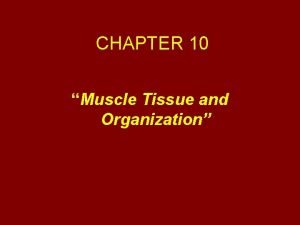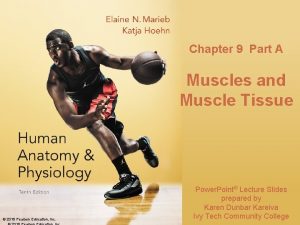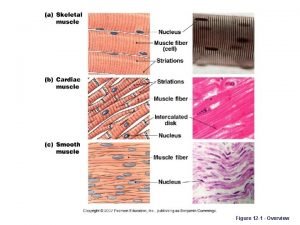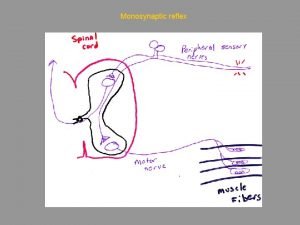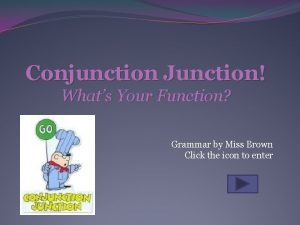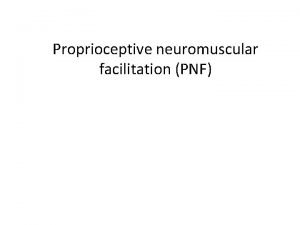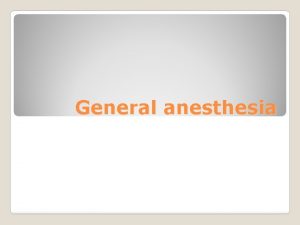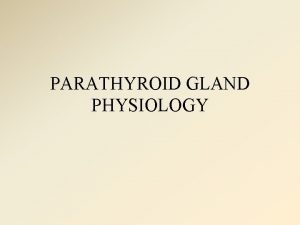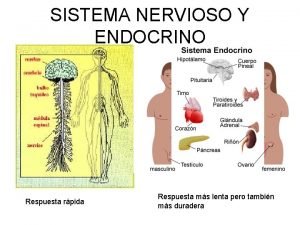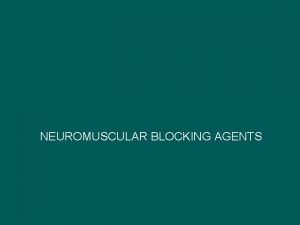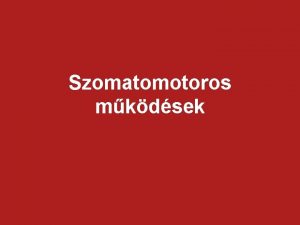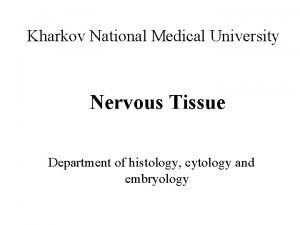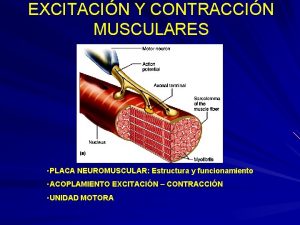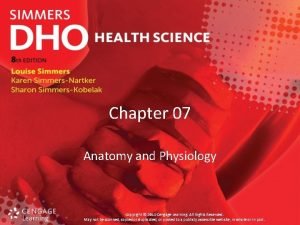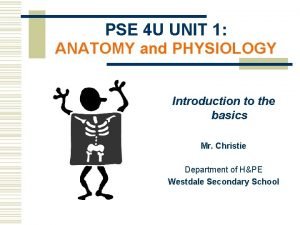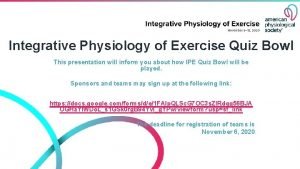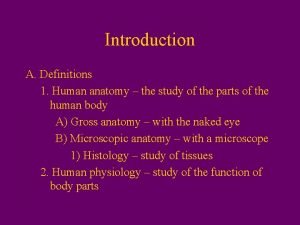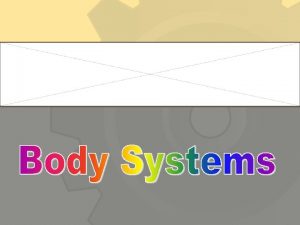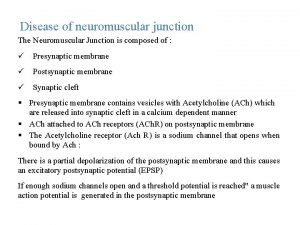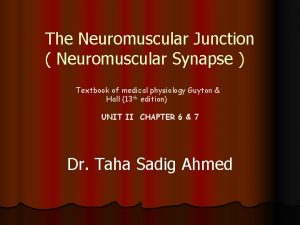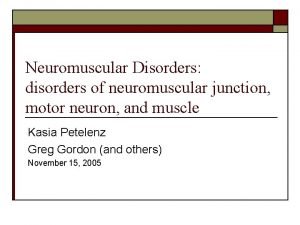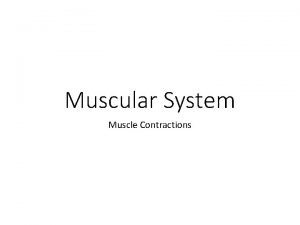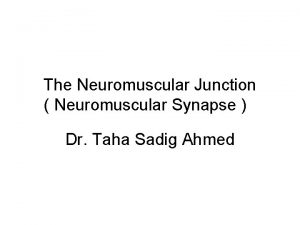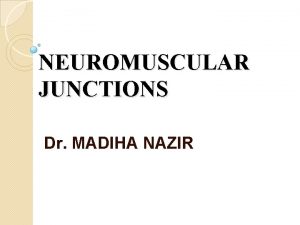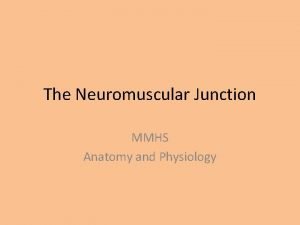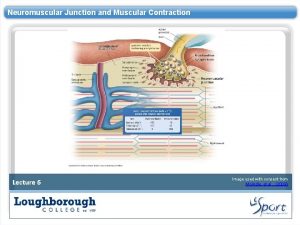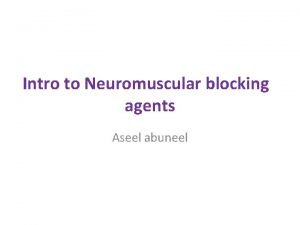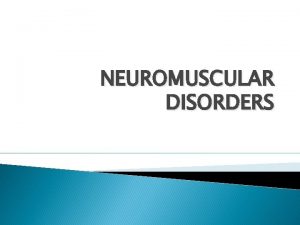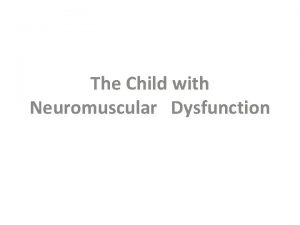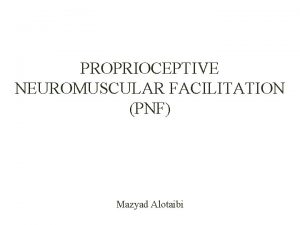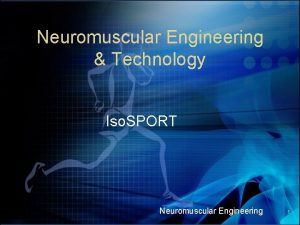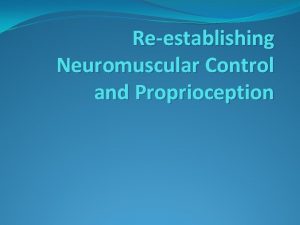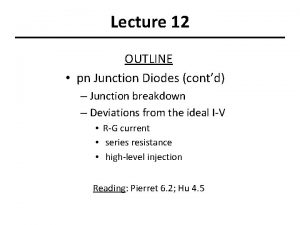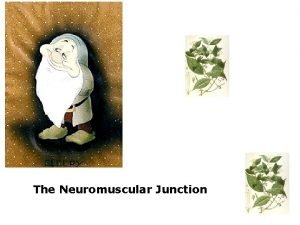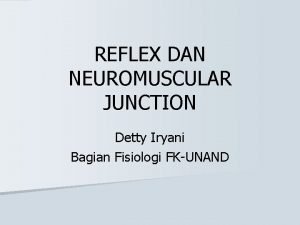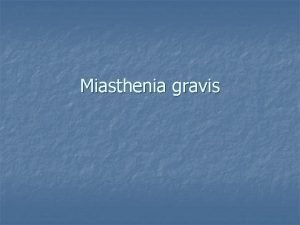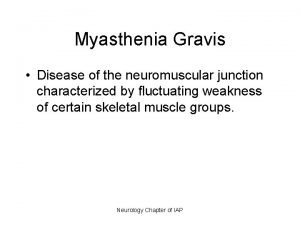PHYSIOLOGY 1 LECTURE 15 NEUROMUSCULAR JUNCTION NEUROMUSCULAR JUNCTION


























- Slides: 26

PHYSIOLOGY 1 LECTURE 15 NEUROMUSCULAR JUNCTION

NEUROMUSCULAR JUNCTION n n n OBJECTIVES: The student should understand: 1. General anatomy of the neuromuscular junction. 2. Secretion of acetylcholine from the presynaptic neuron. 3. Ach receptors are ligand gated Na+ channels. 4. End plate potentials 5. Generation of skeletal muscle action potential

NEUROMUSCULAR JUNCTION INTRODUCTION A. Movement of the body requires the interaction of a complex series of afferent and efferent neuronal signals, which result in a skeletal muscle contraction n B. The neuromuscular junction is a specialized form of a chemical synapse comprised of an alpha motor neuron and the muscle fiber it innervates. n

NEUROMUSCULAR JUNCTION INTRODUCTION Junctions Vrs. Synapses n 1. A junction will always respond to an action potential in the presynaptic nerve. Synapses may or may not. n 2. A junction will have a safety factor, sufficient release of neurotransmitter to insure action potential generation in the effector organ, usually a thousand or so times over. n

NEUROMUSCULAR JUNCTION INTRODUCTION D. Motor neurons (Alpha motor neurons n 1. large myelinated nerve fibers n 2. cell bodies located in the spinal cord or brain stem n

NEUROMUSCULAR JUNCTION INTRODUCTION n n n E. NMJ 1. each nerve fiber branches many times and stimulates from 3 to several hundred muscle fibers 2. usually each muscle fiber has only one NMJ 3. terminal nerve endings make a junction at the midpoint of a muscle fiber 4. AP on the muscle fiber travels from midpoint toward both ends of the muscle fiber

NEUROMUSCULAR JUNCTION INTRODUCTION

NEUROMUSCULAR JUNCTION INTRODUCTION n 3. Motor Unit – a. A single motor neuron and all of the muscle fibers it innervates is called a motor unit – b. Muscle fibers in a single motor unit are all located in one muscle but scattered throughout the muscle – c. A single fiber is controlled by only one motor unit

NEUROMUSCULAR JUNCTION INTRODUCTION – d. When an AP occurs in a motor neuron all muscle fibers in it’s motor unit contract as one

Physiological Anatomy of the NMJ (Motor Endplate) n A. Neuromuscular junction or motor endplate – 1. Axon of motor neuron branches, looses the myelin sheath and forms several axon terminals n a. Axon terminals contain vesicles resembling vesicles found at synaptic interfaces n b. Axon terminals contain the neurotransmitter acetylcholine (Ach)

Physiological Anatomy of the NMJ (Motor Endplate) – 2. Axon terminals invaginate into the muscle fiber – A. Axon terminal and muscle fiber do not physically touch – b. Muscle fiber membrane (postsynaptic) is specialized and is different from the plasma membrane on the rest of the muscle fiber

Physiological Anatomy of the NMJ (Motor Endplate) n 3. Junction is covered by Schwann cells, this insulates the junctional cleft from surrounding fluids and prevents some of the loss of neurotransmitter by diffusion from the cleft

Physiological Anatomy of the NMJ (Motor Endplate)

Physiological Anatomy of the NMJ (Motor Endplate) n 4. Synaptic gutter or trough Invagination of the membrane beneath the axon terminal (postsynaptic membrane) – a. Synaptic cleft - space between axon terminal and synaptic trough n 1. 20 to 30 nm wide n 2. Space filled with ECF, a gel of carbohydrate rich amorphous material

Physiological Anatomy of the NMJ (Motor Endplate) – b. Subneural clefts or folds n 1) Folds of the synaptic trough n 2) Increase postsynaptic surface area n 3) Location of the majority of the acetylcholine receptors (ligand gated Na+& K+ channels) n 4) Basal lamina and postsynaptic membrane contain many molecules of acetylcholinesterase (splits acetylcholine into acetyl. Co. A and choline)

Physiological Anatomy of the NMJ (Motor Endplate) n 5) Active zone of axon terminal is located over the subnerural folds

Physiological Anatomy of the NMJ (Motor Endplate)

Physiological Anatomy of the NMJ (Motor Endplate) n B. Secretion of Ach by neuron and axon terminals – 1. AP along the axon of motor neuron is propagated to axon terminal – 2. Depolarization of the axon terminal opens voltage-gated calcium channels n a. Calcium release causes Ach vesicles to fuse with the axon terminal membranes at the active sites

Physiological Anatomy of the NMJ (Motor Endplate) n b. Ach quanta are released into the synaptic cleft (Guyton - 125 vesicles are released)

Physiological Anatomy of the NMJ (Motor Endplate) – 3. Acetylcholine diffuses across the synaptic cleft and binds with nicotinic ligand-gated channels that allow calcium, sodium, and potassium to move across the postsynaptic membrane n a. Electrochemical gradient across membrane favors more sodium flux inward than potassium flux outward, very little calcium moves across the membrane

Physiological Anatomy of the NMJ (Motor Endplate) n b. Depolarization of the postjunctional membrane occurs and is called an EPP (end-plate potential

NMJ (Motor Endplate) Ligand Gating

Physiological Anatomy of the NMJ (Motor Endplate) C. Destruction of released Ach by acetylcholinesterase n Acetylcholine is rapidly removed by two mechanisms n – 1. Acetylcholinesterase is located on the postsynaptic membrane and the external basal lamina most Ach is broken down by this mechanism – 2. Diffusion - small amounts of Ach diffuse out of the synaptic cleft

Physiological Anatomy of the NMJ (Motor Endplate) D. EPP and excitation of muscle fiber n NMJ postsynaptic membrane is Not electrically excitable and does not fire an AP n EPP is a local graded potential n – 1. EPP is analogous to an EPSP but much larger, all NMJ potentials are excitatory and cause an AP on the adjacent postsynaptic membrane every time

Physiological Anatomy of the NMJ (Motor Endplate) – 2. One EPP is normally more than sufficient to cause AP generation on adjacent skeletal muscle membrane – 3. AP is propagated on skeletal muscle fibers from center toward both ends so that center sarcomeres contract first (prevents excess strain on skeletal muscle fibers and produces a stronger response faster)

NEUROMUSCULAR JUNCTION 1. n 2. n 3. n 4. 5. 6. n Junction vs. Synapse Alpha Motor Neurons Motor Unit NMJ Endplate Potential Muscle Action Potential
 Neuromuscular junction
Neuromuscular junction Focus figure 9.1: events at the neuromuscular junction
Focus figure 9.1: events at the neuromuscular junction Figure 12-1
Figure 12-1 End plate potential
End plate potential Neuromuscular junction
Neuromuscular junction Sequence of events at neuromuscular junction
Sequence of events at neuromuscular junction Microbial physiology notes
Microbial physiology notes Conjunction junction what's your function meaning
Conjunction junction what's your function meaning Bjt lecture notes
Bjt lecture notes 01:640:244 lecture notes - lecture 15: plat, idah, farad
01:640:244 lecture notes - lecture 15: plat, idah, farad Pnf stretching definition
Pnf stretching definition Cheap diazepam
Cheap diazepam Hypocalcemia neuromuscular excitability
Hypocalcemia neuromuscular excitability Sinapsis
Sinapsis Husos musculares y organos tendinosos de golgi
Husos musculares y organos tendinosos de golgi Neostigmine atropine reversal
Neostigmine atropine reversal Acondicionamiento neuromuscular dibujos
Acondicionamiento neuromuscular dibujos Neuromuscular
Neuromuscular Neuromuscular spindle
Neuromuscular spindle Estructura de la placa neuromuscular
Estructura de la placa neuromuscular Anatomy and physiology of the retina
Anatomy and physiology of the retina Introduction of urinary system
Introduction of urinary system Cengage anatomy and physiology
Cengage anatomy and physiology Pse 4
Pse 4 Exercise physiology quiz
Exercise physiology quiz Physiology definition
Physiology definition Anatomy and physiology body parts
Anatomy and physiology body parts
